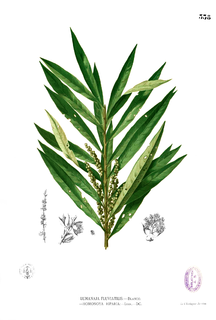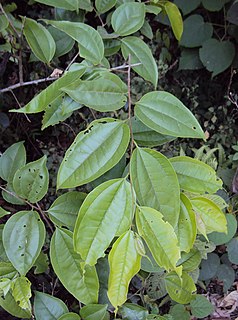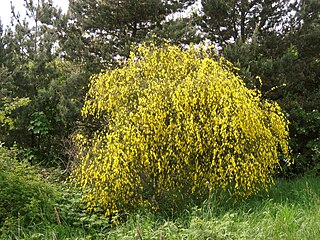Colobocarpos is a monotypic plant genus of the family Euphorbiaceae. The sole species is Colobocarpos nanus. It is native to Laos and Northern Thailand.
Pachystroma is a monotypic plant genus in the family Euphorbiaceae first described as a genus in 1865. It is the only genus of its tribe (Pachystromateae). The only known species is Pachystroma longifolium, native to Brazil, Bolivia and Peru.
Sampantaea amentiflora is a plant species of the family Euphorbiaceae, first described as a genus in 1972. The genus Sampantaea is monotypic and found in Thailand and Cambodia.

Homonoia is a plant genus of the family Euphorbiaceae first described in 1790. These are rheophytes and usually found in groups at riverbanks in India, southern China, Southeast Asia, and New Guinea.
- Homonoia intermediaHaines - India
- Homonoia retusa Müll.Arg. - India
- Homonoia riparia Lour. - Guangxi, Guizhou, Hainan, Sichuan, Taiwan, Yunnan, Cambodia, India, Assam, Bhutan, Sri Lanka, Borneo, Java, Lesser Sunda Islands, Sulawesi, Sumatra, Maluku, Laos, Malaysia, Myanmar, Philippines, Thailand, Vietnam, New Guinea, Andaman & Nicobar Islands
Conceveiba is a plant genus of the family Euphorbiaceae, first described as a genus in 1775. It is native to South America and Central America.
- Conceveiba guianensisAubl. - Brazil, Peru, Bolivia, Ecuador, Colombia, Venezuela, 3 Guianas
- Conceveiba hostmaniiBenth. - Guyana, Suriname, Amazonas State in Brazil
- Conceveiba krukoffiiSteyerm. - Venezuela, French Guiana, NW Brazil
- Conceveiba latifoliaBenth. - Colombia, Venezuela, Peru, Amazonas State in Brazil
- Conceveiba martianaBaill. - Venezuela, French Guiana, NW Brazil, Colombia, Ecuador, Peru, Bolivia
- Conceveiba maynasensisSecco - Loreto in Peru
- Conceveiba parvifoliaMcPherson - Panama, NW Colombia
- Conceveiba pleiostemonaDonn.Sm. - Costa Rica, Nicaragua, Colombia, Venezuela
- Conceveiba praealta(Croizat) Punt ex J.Murillo - NW Brazil
- Conceveiba ptariana(Steyerm.) Jabl. - S Venezuela
- Conceveiba rhytidocarpaMüll.Arg. - Colombia, Ecuador, Peru
- Conceveiba santanderensisJ.Murillo - NW Colombia
- Conceveiba terminalis(Baill.) Müll.Arg. - Venezuela, Guyana, Suriname, NW Brazil, Colombia, Peru
- Conceveiba tristigmataJ.Murillo - Colombia, Venezuela, NW Brazil

Alchorneopsis is a genus of flowering plants in the family Euphorbiaceae first described as a genus in 1865. It is native to Central America, the Greater Antilles, and northern South America.
- Alchorneopsis floribunda(Benth.) Müll.Arg. - Costa Rica, Honduras, Panama, Puerto Rico, Dominican Republic, 3 Guianas, Colombia, Venezuela, Ecuador, Peru, NW Brazil
- Alchorneopsis portoricensisUrb. - Puerto Rico
Philyra is a plant genus of the family Euphorbiaceae first described as a genus in 1841. It contains only one known species, Philyra brasiliensis, native to Brazil, Paraguay, and northeastern Argentina.

Adenochlaena is a genus of plant of the family Euphorbiaceae first described as a genus in 1858. It is native to certain islands in the Indian Ocean.
- Adenochlaena leucocephalaBaill. - Madagascar, Comoros
- Adenochlaena zeylanica(Baill.) Thwaites - Sri Lanka
Cephalocroton is a genus of plant of the family Euphorbiaceae first described as a genus in 1841. It is native to central, eastern, and southern Africa from Nigeria and Ethiopia south to KwaZulu-Natal.
Epiprinus is a genus of plant of the family Euphorbiaceae first described as a genus in 1854. It is native to Indochina, Sumatra, southern China, and the Indian Subcontinent.
- Epiprinus balansae(Pax & K.Hoffm.) Gagnep. - Vietnam
- Epiprinus lanceifoliusCroizat - Vietnam
- Epiprinus malayanusGriff. - Myanmar, Thailand, Peninsular Malaysia, Sumatra
- Epiprinus mallotiformis(Müll.Arg.) Croizat - southern India
- Epiprinus poilaneiGagnep. - Vietnam
- Epiprinus siletianus(Baill.) Croizat - Hainan, Yunnan, Assam, Laos, Myanmar, Thailand, Vietnam
Muricococcum is a genus of plant of the family Euphorbiaceae first described as a genus in 1956. It contains only one known species, Muricococcum sinense, native to southern China and northern Vietnam.
Erismanthus is a plant genus of the family Euphorbiaceae first described as a genus in 1866. It is native to Southeast Asia and southern China.
- Erismanthus obliquusWall. ex Müll.Arg. - S Thailand, Malaysia, Borneo, Sumatra
- Erismanthus sinensisOliv. - Cambodia, Laos, Thailand, Vietnam, Hainan
Cnesmone is a genus of plant of the family Euphorbiaceae first described as a genus in 1826. It is native to southern China and to much of Southeast Asia.
Megistostigma is a genus of plant of the family Euphorbiaceae first described as a genus in 1887. It is native to southern China, Assam, and Southeast Asia.
- Megistostigma burmanicum - Assam, Myanmar, Thailand, Perlis
- Megistostigma cordatum - Sumatra, Sabah, Samar
- Megistostigma glabratum - Peninsular Malaysia, Anamba Islands, N Sumatra
- Megistostigma peltatum - Siberut, Natuna, Java
- Megistostigma yunnanense - Yunnan
Botryophora is a genus of plant of the family Euphorbiaceae first described as a genus in 1888. It contains only one known species, Botryophora geniculata, native to Thailand, Myanmar, Malaysia, Borneo, Sumatra, and Java.
Endospermum is a genus of plants, under the family Euphorbiaceae and the monotypic subtribe Endosperminae first described as a genus in 1861 It is native to E + S + SE Asia, Papuasia, Queensland, and certain islands of the W Pacific.

Blachia is a genus of plants under the family Euphorbiaceae first described as a genus in 1858. It is native to Southeast Asia, southern China, and the Indian Subcontinent.
Strophioblachia is a genus of plants in the family Euphorbiaceae first described as a genus in 1900. It contains only one known species, Strophioblachia fimbricalyx, native to southern China, E Indochina, the Philippines, and Sulawesi.

Celtis timorensis, commonly known as stinkwood or stinking wood, is a species of flowering plant in the Cannabaceae family that grows in tropical Asia. The specific epithet comes from the name of the island of Timor, the locality of the type collection.
Melanolepsis multiglandulosa is a plant species of the family Euphorbiaceae, first described in 1826. It is native to Nansei-shoto, Mariana Islands, Solomon Islands, Bismarck Archipelago, New Guinea, Maluku, Sulawesi, Philippines, Lesser Sunda Islands, Java, Sumatra, Borneo, Thailand, Malaysia and Taiwan.






